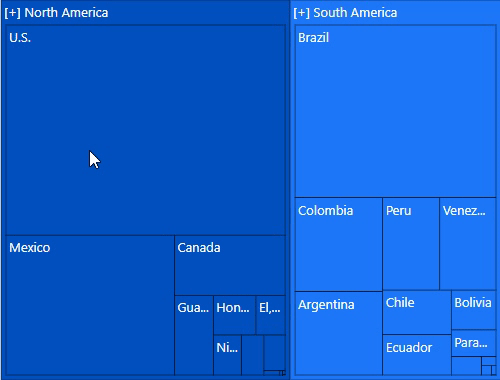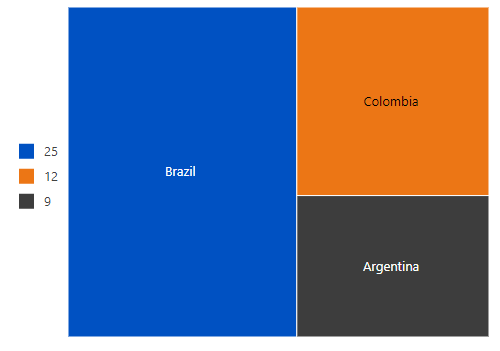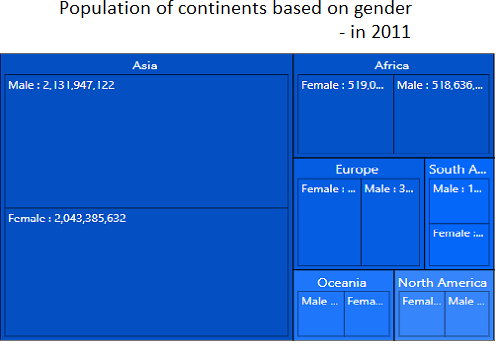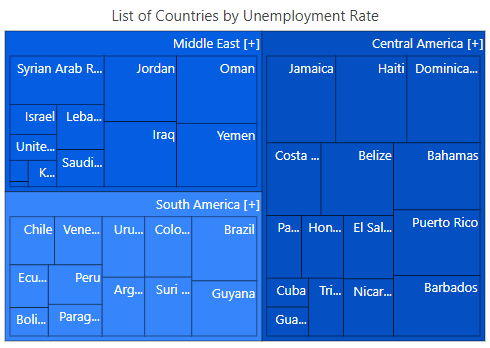Trusted by the world’s leading companies

Overview
The ASP.NET MVC TreeMap is a feature-rich control used to visualize both hierarchical and flat data. Customize the look and feel of the TreeMap by using built-in features like color mapping, legends, and label templates.
Leaf node
A TreeMap contains groups of data collections. Each group has one or more leaf nodes. Each leaf node is displayed as a rectangle, sized and colored according to values that you assign.

Levels
Render any number of child items for each individual node in a TreeMap and they are categorized them to form levels.

Color mapping
Categorize the nodes by customizing their colors based on the underlying values.

Range color mapping
Apply colors to the nodes by comparing their values with a desired numeric range. For example, colors can be applied to countries based on their population growth.

Equal color mapping
Use equal color mapping to differentiate an item’s fill based on its underlying value and color. For example, colors can be applied to states based on a winning candidate.

Desaturation color mapping
Apply colors to the nodes by comparing their values with desaturation color order. For example, transparent color can be applied to countries based on their population variation from higher to lower.
Data labels
Data labels in the ASP.NET MVC TreeMap control are used to display more details about a particular item. Labels can be trimmed, hidden, or wrapped if the label width exceeds the item bounds.

Label template
Render any HTML element as a label for the nodes in the a TreeMap.

Drill-down
ASP.NET MVC TreeMap control provides support to drill the parent items to have a more detailed look at their child items.

Legend
Use legend to add additional information for interpreting a TreeMap with various colors, shapes, or other identifiers. It provides two types of legend: default and interactive.
Legend types
The ASP.NET MVC TreeMap control provides two types of legend, default and interactive.

Default
A default legend contains swatches of symbols with descriptions to denote the categories of items.

Interactive
An interactive legend is used to find the range of an underlying item’s value on mouse over.
Legend customization

Legend position
Position the legend to top, bottom, left, or right of the TreeMap.

Legend item shape
Change the legend item shape to a circle, rectangle, or another built-in custom shape to represent the items.
Layout types
Use different layouts types to view the child nodes in effective ways.

Squarified
Visualize the data in the form of square-like rectangles with best aspect ratio in this layout.

Auto slice and dice
Visualize the data in the form of long, thin rectangles that can be displayed either vertically or horizontally with high aspect ratio in this layout.

Horizontal slice and dice horizontal
This layout creates rectangles with high aspect ratio and displays them horizontally.

Vertical slice and dice
This layout creates rectangles with high aspect ratio and displays them sorted vertically.
Tooltip
When the mouse hovers over the an item, the interactive ASP.NET MVC TreeMap control displays details about the item’s values in a tooltip.

Selection and highlighting
Select a particular shape on mouse click and highlight on mouse over to bring it to the center of attraction over other items in the TreeMap.

Title and subtitle
Add a title and subtitle to visualize additional information on a TreeMap. You can customize the font and alignment of the titles and subtitles.

Appearance
Customize the look and feel of a TreeMap by changing the fill color, background, border, and opacity of the items.

Node customization
Change the fill color, background, border, and opacity of the nodes to customize the appearance.

Gap customization
Enhance the readability by customizing the gaps within the groups of leaf nodes.

Palette
Built-in palettes with customizable options are available by default.
Right to left (RTL)
You can render the TreeMap elements like nodes, headers, labels, and legends in the right-to-left direction.

Exporting
Export the TreeMap to a PDF document or in image formats such as SVG, PNG, and JPEG in client-side.

Export
Exports the TreeMap to a PDF document or in image formats such as SVG, PNG, and JPEG in client-side.

Print the rendered TreeMap directly from the browser.
Touch and browser support
The interactive TreeMap control supports touch interactions.

Touch support
All the TreeMap features will work on touch devices with zero configuration. Use touch features such as tooltips, drill-down, selection, and highlighting without any customization.

Responsive
You can view the ASP.NET MVC TreeMap control on various devices. Hide specific elements in a TreeMap for particular screen sizes by making a very minimal change in the TreeMap events.

Cross-browser support
You can render the TreeMap component in all modern browsers.
Other supported frameworks
The TreeMap component is also available in Blazor, React, Angular, JavaScript and Vue frameworks. Check out the different TreeMap platforms from the links below,
140+ ASP.NET MVC UI CONTROLS
Our Customers Love Us


 Documentation
Documentation
Awards
Greatness—it’s one thing to say you have it, but it means more when others recognize it. Syncfusion® is proud to hold the following industry awards.














